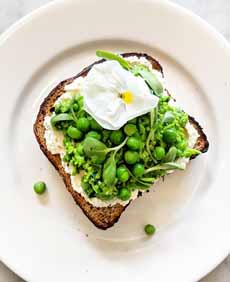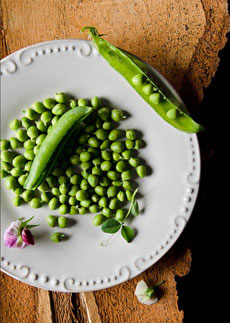RECIPE: Spring Pea Crostini
 [1] Spring Pea Crostini (photo courtesy Hannah Kaminsky | Bittersweet Blog).
|
One of the great treats of spring is spring peas, also known as English peas and garden peas.
With their beautiful color and fresh sweetness, they should be substituted for the ubiquitous avocado toast during their limited spring run. Simply mash them into a chunky spread with bright mint and lemon accents, and spread the mixture on your toast. Our colleague Hannah Kaminsky went one step further and created a more sophisticated tartine (French for an open-face sandwich, photo #1). Her recipe is below. While we might call it a mash, she calls the recipe pistou, after the French condiment that uses the same ingredients. Pistou (pee-STEW) is a cold sauce that originated in Provence, the southeast region of France that borders Italy. However, recipes by other names have a much longer history. The Roman poet Virgil described a sauce made by crushing herbs in a mortar with garlic, salt and olive oil. He was not specific about the herbs. Over time, the sauce evolved into the basil-based Genovese pesto and pistou in Nice—both areas rich in basil. Pistou is the Provençal word for “pounded,” after the traditional method of pounding the ingredients using a mortar and pestle (Virgil’s cook did it the same way). And like Virgil’s recipe, the original Provençal pistou sauce has just three ingredients: fresh herbs (basil), cloves of garlic and olive oil. Is Pistou The Same As Pesto? Some people think pistou is the same as Italian pesto, which originated in Genoa, the capital of the region of Liguria. But it is different: There are no pine nuts or grated pecorino/parmesan in classic Provençal pistou. Over time, every recipe gets enhanced by creative cooks. Today, some pistou recipe variations include grated cheese, chili flakes or lemon juice. Some cooks add mint or sage. Some add tomatoes. Some even add nuts, which creates a vegan pesto (no cheese). As long as it contains herbs, garlic and olive oil, it’s pistou. Hannah Kaminsky has taken an even different direction, substituting mint for the basil and adding and spinach and fresh peas. How To Use Pistou Pistou is most popularly used in the Provençal dish soupe au pistou, a soup similar to minestrone that can include white beans, string beans, tomatoes, potatoes, summer squash, pasta and herbs. Other vegetable-rich soups can also get the pistou treatment, to enliven the flavors of the soup. The pistou is incorporated into the soup just before serving. Like pesto, pistou is very versatile: added to bean salad; atop crostini or bruschetta (the difference), toast or plain bread; with grilled meats (Argentine chimichurri is a similar sauce made with parsley); or used, like pesto, as a pasta sauce. Try it as a condiment with eggs. Crostini sounds exotic, but it’s just Italian for toasted bread. The bread used is an Italian loaf, so it’s different from large, flat American slices. With bruschetta, the bread is grilled, not toasted. Here are more differences. The pistou can be prepared in advance and stored in an airtight container in the fridge for 3-4 days. Ingredients For 4 Servings For The Minted Pea Pistou |
|
|
Preparation 1. MAKE the pistou. Place the mint, spinach, garlic oil, and lemon juice in the food processor and blend until the leaves are broken down and the mixture is fairly smooth. Pause to scrape down the sides of the container as needed. 2. ADD the peas, salt and pepper, and pulse until spreadable but still slightly coarse. 3. TOAST the bread and add a thick layer of ricotta to each slice. Follow with the pea pistou and garnish with fresh peas, pea shoots, and edible flowers. Savor a taste of spring, no matter the weather outside! ________________ *We buy garlic-infused olive oil, but you can infuse your own. Place the 4 tablespoons of olive oil in a small pan with a peeled, crushed garlic clove; the extra tablespoon is to allow for loss during the cooking process. Sauté the garlic over medium heat for three to five minutes. The garlic should sizzle, but not cook. Lower the heat if it starts to brown around the edge. Turn the heat off and let the oil cool. Remove the garlic and use the oil. The reason for cooking the oil is to avoid any botulism present in the garlic. It’s a small risk, but still possible.
|
||






